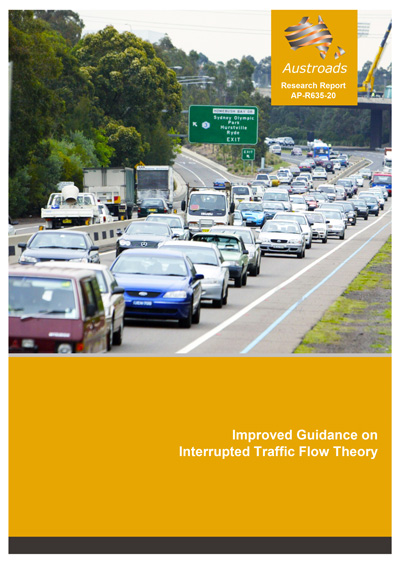Traffic Management

- Publication no: AP-R635-20
- ISBN: 978-1-922382-28-3
- Published: 1 October 2020
- PDF (free) Download
This report summarises activities undertaken to update guidance on interrupted traffic flow theory contained within Austroads Guide to Traffic Management Part 2 and Part 3. The updates to the guidance will enable practitioners to improve their fundamental understanding of interrupted traffic flow theory and more effectively manage congestion on the road network.
A literature review has been undertaken to identify new practices relating to interrupted traffic flow theory. Key areas identified for development in Part 2 and Part 3 include bottlenecks, travel time reliability, roundabout theory, analysis of signalised intersections, active transportation and demand management, multi-modal considerations and traffic flow impacts of heavy vehicles.
Three case studies have been developed to demonstrate key theories and processes outlined in the guide. The case studies support the content provided within the guides and provide commentary to explain the decision making processes and interpretation of results.
- Summary
- 1. Introduction
- 1.1 Project Background
- 1.2 Purpose
- 1.3 Scope
- 1.4 Project Methodology
- 1.4.1 Project Staging
- 1.4.2 Stakeholders
- 1.4.3 Case Studies
- 1.5 Abbreviations
- 2. Literature Review Summary
- 3. Proposed AGTM Revisions
- 3.1 AGTM Part 2
- 3.1.1 Overview of Changes
- 3.1.2 New Content
- 3.2 AGTM Part 3
- 3.2.1 Overview of Changes
- 3.2.2 Removal of Content
- 3.2.3 New Content
- 3.3 Case Study Summaries
- 3.3.1 Case Study 1: Calculating Reliability and Performance Across a Day
- 3.3.2 Case Study 2: Signalised Intersection Worked Example
- 3.3.3 Case Study 3: Roundabouts - Comparing Different Intersection Geometries
- 3.1 AGTM Part 2
- 4. Conclusion
- References
- Appendix A Travel Time Reliability Case Study
- A.1 Expanding on future Section 4.6 Travel Time Reliability of AGTM Part 3
- A.2 Case Study Example
- A.2.1 Study Corridor
- A.2.2 Travel Time Data
- A.2.3 Travel Time Evaluation
- Appendix B Signalised Intersections Case Study
- B.1 Base Scenario
- B.2 Capacity Analysis
- B.2.1 Observed Flows
- B.2.2 Base Saturation Flow
- B.2.3 Adjustment of Base Saturation Flows
- B.2.4 Determine Critical Movements
- B.2.5 Capacity Analysis
- B.2.6 Measures of Intersection Performance
- B.2.7 Interpretation of Output Results
- B.3 Mitigation Scenario 1 – Through Traffic Queuing
- B.3.1 Issue
- B.3.2 Solutions
- B.3.3 Performance Analysis
- B.3.4 Discussion
- B.4 Mitigation Scenario 2 – Side Street Over Capacity
- B.4.1 Issue
- B.4.2 Solution
- B.4.3 Performance Analysis
- B.4.4 Discussion
- B.5 Lane Utilisation
- B.5.1 Base Scenario
- B.5.2 Lane Utilisation Sensitivity
- Appendix C Roundabouts Case Study
- C.1 Expanding on Section 7.2 Roundabouts of AGTM Part 3
- C.2 Scenario 1 – Increased Lane Widths
- C.3 Scenario 2 – Single-lane to Multi-lane Roundabout
- C.4 Scenario 3 – Diameter
- C.5 Scenario 4 – Movement Allocation
